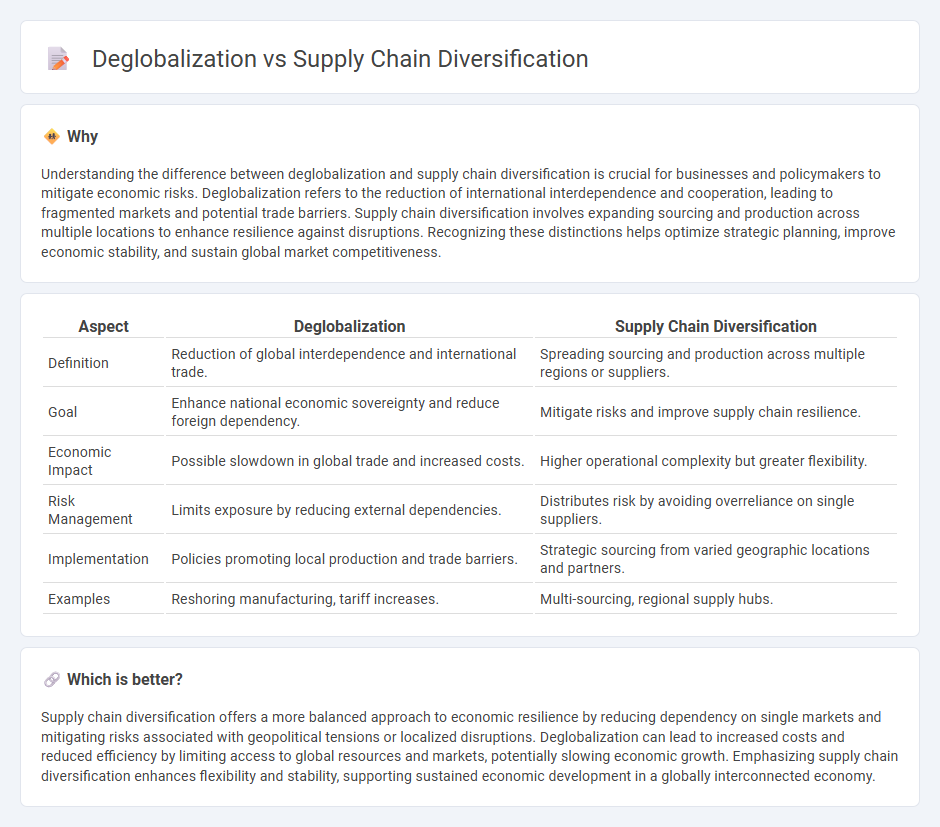
Deglobalization drives shifts in global trade dynamics by reducing reliance on cross-border supply chains and promoting localized production. Supply chain diversification mitigates risks from geopolitical tensions and disruptions by spreading sourcing across multiple regions, enhancing resilience. Explore how these economic strategies impact global markets and corporate decisions.
Why it is important
Understanding the difference between deglobalization and supply chain diversification is crucial for businesses and policymakers to mitigate economic risks. Deglobalization refers to the reduction of international interdependence and cooperation, leading to fragmented markets and potential trade barriers. Supply chain diversification involves expanding sourcing and production across multiple locations to enhance resilience against disruptions. Recognizing these distinctions helps optimize strategic planning, improve economic stability, and sustain global market competitiveness.
Comparison Table
| Aspect | Deglobalization | Supply Chain Diversification |
|---|---|---|
| Definition | Reduction of global interdependence and international trade. | Spreading sourcing and production across multiple regions or suppliers. |
| Goal | Enhance national economic sovereignty and reduce foreign dependency. | Mitigate risks and improve supply chain resilience. |
| Economic Impact | Possible slowdown in global trade and increased costs. | Higher operational complexity but greater flexibility. |
| Risk Management | Limits exposure by reducing external dependencies. | Distributes risk by avoiding overreliance on single suppliers. |
| Implementation | Policies promoting local production and trade barriers. | Strategic sourcing from varied geographic locations and partners. |
| Examples | Reshoring manufacturing, tariff increases. | Multi-sourcing, regional supply hubs. |
Which is better?
Supply chain diversification offers a more balanced approach to economic resilience by reducing dependency on single markets and mitigating risks associated with geopolitical tensions or localized disruptions. Deglobalization can lead to increased costs and reduced efficiency by limiting access to global resources and markets, potentially slowing economic growth. Emphasizing supply chain diversification enhances flexibility and stability, supporting sustained economic development in a globally interconnected economy.
Connection
Deglobalization drives companies to diversify supply chains by reducing reliance on single countries to mitigate geopolitical risks and trade disruptions. Supply chain diversification enhances resilience by sourcing materials and components from multiple regions, aligning with the trend of deglobalization. This strategic shift supports more localized production and inventory management, ultimately stabilizing economic activities amid global uncertainties.
Key Terms
Resilience
Supply chain diversification enhances resilience by spreading risk across multiple suppliers and regions, reducing dependency on any single source or market. Deglobalization shifts focus towards localized or regional supply chains, aiming to minimize exposure to global disruptions but potentially increasing costs and limiting resource access. Explore the strategic balance between diversification and deglobalization to strengthen your supply chain resilience.
Global Value Chains
Supply chain diversification involves spreading sourcing and production across multiple countries to reduce risk and enhance resilience, while deglobalization entails a shift toward localized or regional production, potentially contracting Global Value Chains (GVCs). GVCs currently face pressures from geopolitical tensions, rising costs, and sustainability concerns, prompting firms to balance diversification and localization strategies. Explore how these trends reshape competitive dynamics and investment in GVCs for deeper insights.
Trade Barriers
Supply chain diversification reduces risks by spreading production and sourcing across multiple regions, whereas deglobalization often results from rising trade barriers that limit cross-border economic activities. Trade barriers such as tariffs, quotas, and stricter regulations encourage companies to localize supply chains to avoid increased costs and delays. Explore how shifting trade policies drive strategic shifts in global supply management.
Source and External Links
The high impact of supply chain diversification - This article discusses how supply chain diversification enhances resilience by developing flexibility and redundancy through multiple suppliers and logistics solutions.
5 reasons to implement supply chain diversification - It highlights the benefits of supply chain diversification, including risk reduction and building resilience in the face of disruptions.
Supply Chain Diversification and Resilience - This paper explores the impact of supply chain diversification on resilience, particularly in mitigating the effects of adverse trade shocks using a multi-country trade model.
 dowidth.com
dowidth.com